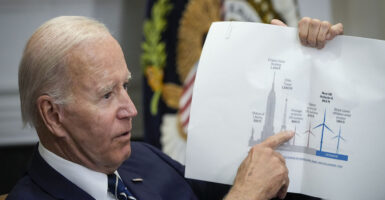A bailout package for the struggling offshore wind industry may be imminent if the industry’s struggles do not abate soon, energy industry and policy experts told the Daily Caller News Foundation.
The Biden administration has heavily subsidized the industry as part of its wider climate agenda, but inflation, supply chain backups, high interest rates, and logistical difficulties have severely affected its prospects in recent months, prompting many companies to signal that their offshore wind investments are in distress.

The wind power industry’s importance to the Biden administration’s green energy plans, as well as the intractable nature of its serious financial problems, make it a prime candidate for government intervention, experts say.
“No one should doubt the willingness of the Biden administration and congressional Democrats to try to spend billions more debt-funded dollars to bail out their pet offshore wind industry,” David Blackmon, a 40-year veteran of the oil and gas business who now writes and consults on energy, told the Daily Caller News Foundation.
“Offshore wind, though completely unnecessary and environmentally destructive, has been a centerpiece of the Green New Deal propaganda, and its supporters will resort to any measures available to keep it on life support,” he continued, adding that “Democrat officials in Northeastern states are similarly willing to loot their state treasuries to throw more money after this failing sector.”
Inflation, supply chain problems, and logistical shortcomings have contributed to significant increases in construction costs across the industry, and refinancing is not an appealing or viable option given the higher cost of borrowing. These factors have combined to produce a bleak financial situation for the industry, just one year after President Joe Biden signed the Inflation Reduction Act, his signature climate bill, into law in August 2022.
“This is what happens when the government tinkers in markets that it has no expertise in,” Daniel Turner, founder and executive director of Power the Future, told the Daily Caller News Foundation.
“It does not matter that it costs an enormous amount of money, jeopardizes the grid’s reliability, or inflicts pain and higher costs on the American people: It is about the agenda and reaching political targets,” Turner added.
The Biden administration is aiming to have offshore wind provide enough power to meet the annual demand of 10 million American homes by 2030, according to the White House. The offshore wind push is a key aspect of the administration’s plans to decarbonize the American energy sector by 2035 and have the overall U.S. economy reach net-zero carbon dioxide emissions by 2050.
However, the industry is beleaguered by the poor financial environment at a time when construction needs to start ramping up to realize the Biden administration’s targets. Wind developers have signaled financial struggles by requesting to renegotiate or terminate power purchase agreements with utility companies, and several have announced that they expect heavy losses.
Siemens Power AG, a wind turbine manufacturer based in Germany that plays a key role in the U.S. offshore wind industry, has reportedly entered into discussions with the German government to secure emergency funding, according to Der Spiegel. The company saw its stock tank by about 33% on Thursday morning as the news took hold in the market, according to data from Google Finance.
General Electric announced on Wednesday that it anticipates its offshore wind operations will lose $1 billion this year, and another $1 billion in 2024.
Orsted, another European company that plays a large role in U.S. offshore developments, announced in August that it was marking down the expected value of its American portfolio by more than $2 billion, and CEO Mads Nipper warned in September that the company may have no choice but to walk away from its U.S. projects if the situation does not improve, according to Bloomberg News. Upon the announcement of the $2.3 billion impairment, Orsted’s stock price has plummeted by about 44%, according to data from Google Finance.
Meanwhile, several other offshore wind developers have paid substantial fines to terminate contracts they signed to supply utility companies with power at agreed-upon rates that no longer appear to be sensible as the financial environment has deteriorated for the developers. Orsted and Equinor-BP petitioned New York state’s utility regulator to allow for renegotiation of their project costs, a request that the state rejected earlier in October.
Several states have already called on the Biden administration to take decisive action to save the offshore wind industry, and Democratic New Jersey Gov. Phil Murphy signed a bill in July that provides an offshore wind developer with a tax break that Republican state Sen. Edward Durr valued at about $1 billion, according to The Associated Press.
In September, Murphy and the Democratic governors of New York, Connecticut, Maryland, Massachusetts, and Rhode Island requested that the federal government “utilize every federal tool available” to keep offshore wind developments afloat.
“Without federal action, offshore wind deployment in the U.S. is at serious risk of stalling because states’ ratepayers may be unable to absorb these significant new costs alone,” the governors stated in their letter to Biden. “Absent intervention, these near-term projects are increasingly at risk of failing.”
Because congressional Republicans may be unlikely to support a stand-alone bailout package, their Democratic colleagues may move to wedge a bailout provision into debt ceiling negotiations that could happen as early as November, Blackmon told the Daily Caller News Foundation.
“If wind power is as great as advocates claim it is, then it should not need a federal bailout,” Kevin Dayaratna, a senior research fellow and data analyst for The Heritage Foundation, told the Daily Caller News Foundation. “These discussions about potentially bailing out the wind industry merely illustrate the industry’s incapability of being a reliable form of energy that can stand on its own.”
The White House and the Department of Energy did not respond immediately to requests for comment.
This report originally was published by the Daily Caller News Foundation
Have an opinion about this article? To sound off, please email letters@DailySignal.com, and we’ll consider publishing your edited remarks in our regular “We Hear You” feature. Remember to include the URL or headline of the article plus your name and town and/or state.

























